EMMA IS Hans van de Weijer - Safety Footwear Advisor
18 August 2025Podoscope provides technical support for foot problems
Recently, a podoscope was added to his fitting bus: a device that uses mirrors to give a realistic footprint. “It helps us to identify foot problems and give appropriate advice. Often just a small adjustment, like a different shoe or a special footbed, is sufficient to ensure that people step outside with a comfortable safety shoe.”
Back to 1978. Hans van de Weijer begins at EMMA in the sewing room. He soon switches to the lasting process, where for more than 20 years he works as foreman. Together with 30 colleagues, he makes some 800 to 900 shoes a day. He continues his career in the technical department, where safety shoes are adjusted for ‘difficult cases’. With a small van, Hans crosses the country, visiting clients. Armed with a shoebox and a notebook. It was the start of EMMA's fitting bus. Twenty years on, Hans still enjoys advising his customers in this ‘travelling shoe shop’.
Exercise for energy
“I work four days a week and travel all over the Netherlands and Belgium. In order to compensate for the many hours ‘on the road’, I exercise a lot. Running and fitness, for example. That gives me energy, allowing me to easily manage what are sometimes long days. In fact, it's also what makes my job such fun! Sometimes I'm out from 6 am to 6 pm, and sometimes I work just a small part of the day. One day, I'm at a large multinational, the next, I park my bus at an SME. This variety really appeals to me. And the connection with customers! I now have considerably more customer contact than when I worked in the factory and I genuinely contribute to customer satisfaction.”
Measuring up safety shoes on site
EMMA's fitting bus was launched to ensure a perfect fit for safety shoes. The Safety Footwear Advisors at EMMA Safety Footwear come along to a company's premises. Hans is one of them. “Employees come to my bus one by one for a personal consultation. With specific questions relating to requirements, activities and any foot complaints, I determine which safety shoes are suitable. After that, we carefully measure the foot length, width, instep height and shape. Then, the fitting session begins, in which someone can try on several models and sizes. Ultimately, my goal is for someone to step outside again with the correct, comfortable shoe and a good feeling.”
"Ultimately, my goal is for someone to step outside again with the correct, comfortable shoe and a good feeling.”
Podoscope identifies foot ailments
On-site fitting is efficient and avoids returns. But well-fitting safety shoes are also important to prevent complaints and problems. The standard EMMA range of safety shoes is not suitable for everyone, however. “Some people have a high instep, flat feet or a bump on their big toe (Hallux Valgus). Or they suffer from overpronation, whereby the foot rotates too far inwards when walking. They require an adjustment in their safety shoes, in order to work comfortably. For these people, we have recently added a podoscope to our fitting bus. This is a tool that uses mirrors to give a realistic footprint.” Hans and his colleagues followed special training to decipher these footprints. “There, we learned that you can see on a footprint which shoes are suitable for ailments and which adjustments can help with a foot problem. We apply this knowledge to help people. Often a different shoe, special footbed, support sole or a small adjustment to an existing shoe is enough. Occasionally, we refer someone to a podiatrist. In any case, we always ensure that someone can work both safely and comfortably wearing safety shoes from EMMA Safety Footwear.”
"We always ensure that someone can work both safely and comfortably wearing safety shoes from EMMA Safety Footwear.”
100% level
The fact there is now always a podoscope on the fitting bus adds some extra challenges for Safety Footwear Advisors at EMMA. “In order to make a good scan, the bus must be completely level. If the bus slopes to the right, the impression of the right foot on the podoscope will be stronger and therefore unrealistic. The podoscope also requires electricity, so we search for a parking place near a socket outlet. Fortunately, if that is impossible, we always have a battery with us, allowing us to work for several hours.”
Language is really important
Before Hans and his colleagues had the podoscope, they identified foot ailments by visually inspecting the foot and asking specific questions. “Then, language was really important. Just try and explain in a foreign language what is bothering you … In addition to Dutch, I could already speak German and English. With that I was already able to assist most of our customers. However, I also travelled a lot around Wallonia (Belgium), where the main language is French. So, I did a two-year course in French, allowing a decent discussion with French speakers on the bus.” Even so, the advice from Hans and his colleagues was still based on assumptions, and Safety Footwear advisors are no doctors. “Thanks to the podoscope, we can add technical input to what we see with the naked eye and learn from discussions. That makes our advice stronger and demonstrates to employers that shoe fitting is really essential.”
“It is greatly appreciated when I address people in their own language on the bus.”
So the whole French course was not for nothing? “No, not at all! It is still greatly appreciated when I address people in their own language on the bus. It breaks the ice immediately, which means that people are more open to advice. That means that the fitting session is also more relaxed. And I love to travel. My wife and I regularly go to Indonesia, Vietnam or Thailand. Then too, it is really handy to speak different languages!”


